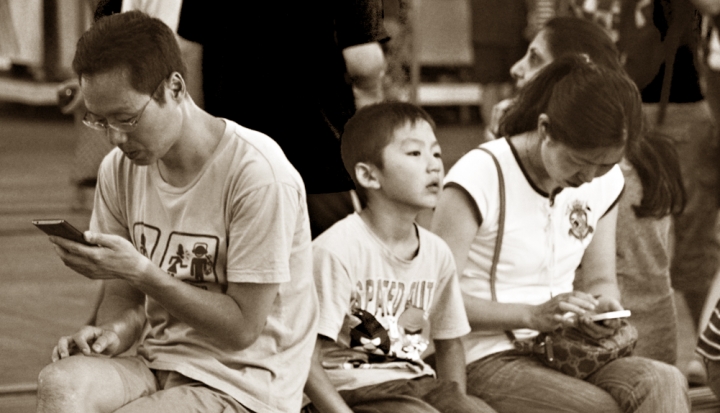I used to have a neighbor, an elderly gentleman who walked up and down the streets of our quiet neighborhood most afternoons, ready to talk to whoever crossed his path. If he came upon you, you had no choice but to slow down and settle in for a good, long chat. Not that this was a burden. Gene was charming, a generous listener, and an easy presence. When I was a new mom, in that isolated stage of caring for a newborn, I would watch out the window for Gene to pass by and would hurry the baby into the sling so I could join him. “You know what the problem with the world today is?” Gene was fond of asking. “Garages,” was his answer. “Because people just come home from work, pull into their garages, and shut the garage doors behind them. There’s no reason to talk to your neighbors anymore.”
Life bubbles over with a thousand ways to connect with one another. We can text, tweet, Facebook, Facetime, Skype, Snapchat, and Instagram. But actually talking to someone face-to-face, let alone taking a nice leisurely walk with them, is a challenge. I’ve actually received a text follow-up to an unanswered call that said, “Busy right now, what did you need?” I’m here to say that the cell phone is the new garage—a place people can pull into and isolate themselves from actual conversations, a place where we can avoid the work of intimacy.
As a stay-at-home mom, I am guilty of living in the cell phone garage while my children clamor, pound, knock, and yelp for my attention. The beeps, rings, and alerts radiating from my phone are constant lines pulling me away from my children. Meanwhile, the lesson I am teaching them while I stay so ultra “connected” is how to not be connected at all.
The few minutes of attention I give my phone every half-hour or so make me feel more connected to the world, however, the truth is these “social” moments are not real. And worse than that, every moment I reach out for that false sense of connectivity, I’m teaching my children a couple of lessons I don’t want them to learn. First, I’m teaching them that they are not interesting enough to keep my attention. Second, I’m showing them an empty and hollow substitute for real community. In this, my children and I have the same problem. We both need real human connection and we’re not getting enough of it.
My son is 5. He’s at an age where he needs to know I am paying attention to him. He is pushing boundaries and asking interesting questions about life, like what number is after infinity? My 6-month-old daughter is at an age when my voice and attention are truly shaping every part of her. She needs my touch, my eye contact, my response to her coos and shouts. But on my worst days, my head is bowed down, my eyes glued to the glare of my cell phone screen. My children have no choice but to sit and endure the passive abandonment. I am not proud of this. None of us are. But we can’t seem to stop.
A popular study regarding cell phone use and children shows that I am far from alone. Dr. Jenny Radesky and her team observed 55 caregivers as they sat with children during a fast food meal. The results of the observation are not surprising. During the meal, 40 of the 55 caregivers were absorbed in their devices, while the children acted out in an effort to win undivided attention.
Like most parents, I have made unsuccessful attempts to set technological limits in an effort to be more attentive. I have removed Facebook from my phone. I never use my phone at the dinner table. I try to keep it face down to avoid the addictive pull of that flashing red light.
Still, I keep it next to me when I am supposed to be playing trucks with my son. “I’m just going to check this real quick,” I tell him, but he and I both know I am lying. Real quick means however long it takes to read an email, respond to it, check the weather, and maybe look up an article on last night’s episode of Mad Men, all while giving my son and our playtime together the most negligible amount of attention. To top it off, my baby girl watches the whole situation with an alert sort of attention that is a jarring counterpoint to my own lack of attention. It is not a lesson I am proud of teaching them, but like many parents, it is a habit I find incredibly difficult to break.
The efforts many of us make to pull out of our little cell phone garages are largely unsuccessful. We turn off alerts, limit use to certain hours of the day, or even have our spouses hide our cell phones from us, but none of these solutions work because they don’t address the real problem.
The real problem is this: Like our children, we are at a deficit for real connection.
Here’s something I know: I am not supposed to get on the floor to play trucks five times a day. Seriously, I’m 40. That’s not my job and my son and I both know I’m not very good at it. What I am good at is offering my neighbor some sugar for her coffee while our children play on the floor together. This actual socializing makes my children happy. It makes me happy. It makes my neighbor happy.
But this sort of real connection is hard to come by. In its absence, we pull into our cell phone garages and shut the doors. We text, we update our Facebook status, we Instagram charming pictures of our attention-starved children. We try to fill the void left by a social media culture that gives us no practical social skills whatsoever.
I miss my neighbor Gene. I miss our walks. If my children are lucky enough to have a Gene in their lives, I worry they will not know how to talk with him. I worry they won’t even look up long enough from the beeps and flashes of their technological devices to see him walk by.
I want to give my children more of myself. I want to give my children a way out of the cell phone garage. While cutting off my cell phone use cold turkey won’t work, what I can do is take a walk. Sure, my neighbors might start to identify me as that weird lady who is always talking about garages and the weather, but at least I’ll be building a community. I might not be able to totally leave the garage, but at least I can open my door.
This is a web-only sidebar that accompanies “Choose the real friends and family plan” which appeared in the May 2015 issue of U.S. Catholic (Vol. 80, No. 5, pages 33–36).
Flickr image cc by Tina Leggio













Add comment